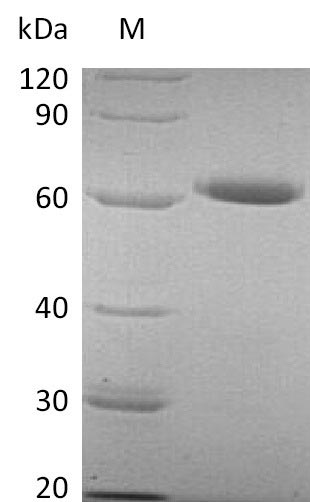Recombinant Human 5'-nucleotidase (NT5E) comes from a mammalian cell system, which appears to help with proper folding and post-translational modifications. This product represents a partial protein covering the 27-547 amino acid region and includes a C-terminal 6xHis-tag that makes purification and detection more straightforward. The purity reaches greater than 95% based on SDS-PAGE analysis, while endotoxin levels stay below 1.0 EU/µg according to LAL method measurements. Functional ELISA testing confirms the protein's biological activity, showing binding capability with an ED50 of 3.33 ng/ml.
5'-nucleotidase, commonly called CD73, serves as a key enzyme in purine metabolism. It drives the dephosphorylation of nucleotide monophosphates to nucleosides and plays a major role in adenosine generation. This protein acts as an essential component across multiple pathways, particularly those connected to immune response, inflammation, and vascular function. Its central position in adenosine signaling has made it an attractive research target in immunology and oncology fields.
Potential Applications
Note: The applications listed below are based on what we know about this protein's biological functions, published research, and experience from experts in the field. However, we haven't fully tested all of these applications ourselves yet. We'd recommend running some preliminary tests first to make sure they work for your specific research goals.
1. Antibody Development and Characterization
This recombinant NT5E/CD73 is confirmed to be antigenically active (ED₅₀ 3.33 ng/ml for mAb binding) and suitable for antibody development. However, the partial sequence (27-547aa) lacks the intracellular and transmembrane domains of full-length CD73, and antibodies generated will not recognize these regions. The C-terminal His-tag may induce tag-specific antibodies. While mammalian expression ensures proper glycosylation, comprehensive antibody validation should include testing against full-length, membrane-associated CD73 to ensure recognition of physiological forms.
2. Functional ELISA Development and Optimization
The protein is appropriate as an ELISA standard, but the soluble extracellular domain may not be recognized by antibodies targeting intracellular epitopes or membrane-proximal regions. The established ED₅₀ provides a reliable reference for assay calibration, but researchers should validate detection sensitivity against full-length CD73 from cell lysates to ensure clinical relevance. Mammalian glycosylation supports authentic epitope presentation.
3. Protein-Protein Interaction Studies
The biologically active CD73 is suitable for interaction studies, but the soluble extracellular domain cannot identify interactions requiring transmembrane or intracellular domains. The His-tag facilitates pull-down assays but may cause steric hindrance for C-terminal interactions. Studies focusing on ecto-5'-nucleotidase activity or adenosine production are well-supported, but interactions involving signaling domains require full-length protein.
4. Biochemical Assay Development
The protein is appropriate as a positive control, but the partial construct lacks the full enzymatic context of membrane-bound CD73. While useful for antibody-based detection assays, functional enzymatic assays require validation with full-length CD73, as membrane anchoring and dimerization affect catalytic efficiency. The mammalian glycosylation ensures proper folding of the enzymatic domain.
5. Structural and Biophysical Studies
The protein is suitable for biophysical characterization of the extracellular domain, but the C-terminal His-tag may interfere with crystallization, and the partial sequence misses structural elements from the missing domains. For full structural biology, tag removal and characterization of the complete protein, including the transmembrane region is preferable. The extracellular domain (27-547aa) contains the catalytic site, making it valuable for enzymatic mechanism studies.
Final Recommendation & Action Plan
This mammalian-expressed human NT5E/CD73 partial protein (27-547aa) with a C-terminal His-tag is a valuable tool for studying the extracellular domain of CD73, particularly for antibody development and immunoassays. However, researchers must account for its lack of transmembrane and intracellular domains. For immediate use: employ it at 1-10 ng/ml based on the ED₅₀ for ELISA development, but validate assays with full-length CD73 from cell membranes. For antibody development, this protein is ideal for generating ectodomain-specific antibodies, but complemented with full-length immunogens for comprehensive coverage. For interaction studies, focus on extracellular binding partners and validate membrane-dependent interactions with full-length CD73. For enzymatic studies, the protein can assess nucleotidase activity, but remember that membrane localization affects substrate access in physiological conditions. The mammalian expression ensures proper glycosylation, which is critical for CD73 function and antibody recognition. Always include appropriate controls for tag-related artifacts and consider that different biological contexts may require full-length CD73 for complete functional studies.






